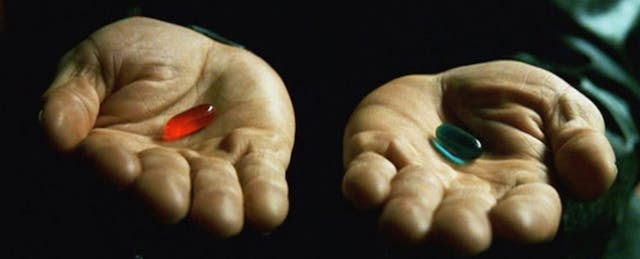Embrace dissonance.
High school students get thirty hours each week with teachers.
Colleges students get twelve hours of teacher-led instruction.
This is a huge chasm for two institutions separated by a three-month summer vacation.
I believe in the power of great teachers. But which is it? Thirty hours of teacher-led instruction? Twelve? Or something in between? And how should learners be spending the rest of their time?
According to my calculations, the sandbox for school innovation measures at least 18 hours per week.
K12 assumes that teachers are primarily responsible for student learning. Higher education assumes that students are primarily responsible for their own learning.
We either need to take the the red pill and create K-12 schools that prepare students to own their learning, or the blue pill and push higher education to do more to improve student outcomes (or both).
The emerging personalized learning movement in K12 is definitely reaching for the red pills. Summit Public Schools, Lindsay Unified School District, USC Hybrid High, Montessori for All and others are all making serious runs at putting students in charge of their learning.
Leave it to two twelve-year-olds to show us what this looks like:
Kid 1: "So what do you think of this [essay]? Would you say it's your best work?"
Kid 2: "I think it's pretty good. It's not as strong as my Rube Goldberg machine because I put more effort into that than this essay."
Kid 1: "Yeah, I have to say, I don't think this is your best work either. It doesn't seem like you really fleshed out what you were trying to say and you only got one piece of feedback from someone else."
Kid 2: "You're totally right. Let me take it down [off the wall.] Can you give me some more feedback on this so I can re-edit?"
This “magic moment” was no accident. The teacher was on the other side of the room when the conversation occurred and it quickly became clear that Acton Academy, an independent school in Austin, TX, was designed from the ground up to promote rich, peer-to-peer learning.
What Acton Academy, Summit, Lindsay Unified and others have in common is that they are creating environments that expand the opportunities for students to have “magic moments” in learning.
Founding Acton Academy teacher Kaylie Reed posits that productive learning environments have many components that are conducive to creating breakthrough moments for students, including one-one coaching, self-paced individualized study, peer networks, technology, socratic discussions, etc.
We put teacher-led instruction on a pedestal for all the right reasons. Most of us have had our lives changed for the better by insanely talented educators. We also have a substantial number of studies demonstrating the enormous power of high-quality, face-to-face instruction.
But independent learning and peer-to-peer learning deserve pedestals of their own too.
What would schools look like that made investments in peer-to-peer or independent learning as large as the one Uncommon Schools made in teacher-led instruction? I revere the book Teach Like a Champion and I’m beginning to wonder if it was meant to be a trilogy.
College--our idealized learning environment--expects that students use an array of available resources and variety of experiences to learn what they need to know.
This is also how life works. One successful jazz guitarist recently shared that he had roughly 200 hours of 1:1 lessons with a teacher (teacher-led), he independently practiced and researched new techniques for about 10,000 hours (independent learning), and learned a lot from other musicians (peer-to-peer).
The mental models we have for education are so deeply ingrained that it is difficult, and sometimes terrifying, to imagine other ways of organizing education.
Embracing dissonance can loosen our thinking about the possibilities for learning.
The ultimate question is: can we improve upon the paradigm of 25-30 similarly-aged students in a classroom with a teacher(s) for 30 hours a week? Or put more simply, are there “better” ways to learn?
The honest answer is we don’t know yet.
Growing up is messy. And so is learning. If there were easy answers, I guarantee that parents would have discovered them by now.
What I do know is a growing numbers of schools and organizations are using their imaginations, their deep expertise, and the voices of students and families to create the next generation of transformative student experiences. These experiences will help students bridge K12 to higher education to life in far more compelling ways.
Did I mention my twins start middle school in two years? They’ll have whatever those twelve-year-olds are having.


